Adderall Skincare Routine: Tips for Managing Skin Changes
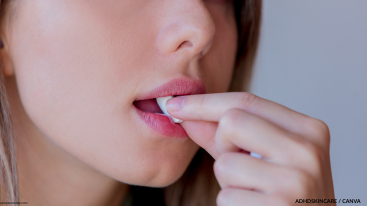
Adderall might help your brain focus, control impulses, and power through tasks, but when it comes to your skin, it’s a different ballgame. As one of the most commonly prescribed medications for ADHD, Adderall is a powerful stimulant that’s FDA-approved to treat both ADHD and narcolepsy. But while it works wonders for productivity, many people don’t realize it can mess with your skin in unexpected ways. That’s why building an Adderall skincare routine isn’t just self-care, it’s damage control.
Stimulants like Adderall can lead to breakouts, dryness, irritation, and even changes in skin sensitivity. Knowing what to expect (and how to manage it) can make all the difference. From unexpected acne development to persistent dryness or even itchiness, these skin changes can feel like they come out of nowhere, especially if you’re already dealing with the everyday chaos of ADHD.
Understanding how Adderall influences your skin (and why) allows you to spot issues early, tailor a consistent skincare routine to meet your skin’s shifting needs, and stay ahead of any long-term damage. Whether you’re seeing increased acne, struggling with dry patches, or noticing sensitivity that wasn’t there before, this guide breaks down how to care for your skin effectively while taking a prescription stimulant like Adderall.
Understanding Adderall’s Impact on Skin Health

Adderall can cause hormonal fluctuations that lead to acne breakouts, dry skin, oily skin, and many other skin problems. For many users, these changes seem to appear out of nowhere, but they’re more common than people realize. Adderall works in the body by influencing neurotransmitters and various bodily systems, not just the brain.
The stimulant effects of Adderall can also disrupt sleep patterns, which leads to dehydrated skin and increased oil production. It’s a frustrating cycle: your skin gets dry from poor sleep, then overcompensates by producing more oil, setting the stage for even more breakouts.
Beyond that, Adderall’s effects on the central nervous system can increase stress levels, and as we all know, stress is a major trigger for acne and other skin problems. Adderall’s effects may also impact aging processes, as sleep disruption and physiological changes can influence aging biomarkers and physical appearance.
Additionally, vasoconstriction caused by Adderall can reduce blood flow to the skin, sometimes making the skin appear pale or dull. Adderall also causes changes in blood pressure, which can affect facial appearance and skin health.
That’s why individuals taking Adderall should be aware of the potential skin effects and take steps to maintain overall skin health. An Adderall skincare routine that includes gentle cleansers and moisturizers can go a long way in protecting the skin barrier and keeping skin calm, balanced, and resilient.
Does Adderall Cause Dry or Oily Skin?
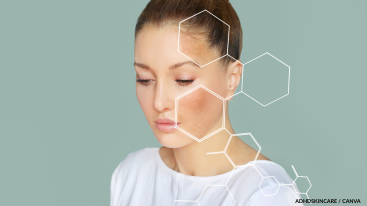
Adderall can cause dry skin and oily skin, even if that wasn’t your original skin type to begin with. These changes can affect all skin types, including oily, dry, and combination skin. In other words, Adderall impacts a wide range of individuals, especially if you don’t have a dedicated Adderall skincare routine. Here’s how:
Dehydration
Adderall is a stimulant, and like many stimulants, it can suppress your thirst. If you’re not drinking enough water throughout the day, your skin can become dehydrated, dull, and tight-feeling. This can lead to dehydration underneath and overcompensating oiliness on top, making your skin feel both oily and tight at the same time. It’s important to stay hydrated to maintain skin health and help prevent dry skin.
Decreased appetite
Adderall use can decrease appetite, which may contribute to dehydrated skin and potential nutritional deficiencies. These changes can make hormonal acne and acne flare-ups more likely, as elevated cortisol levels and shifts in hormonal balance are common effects of Adderall.
Sleep Disruption
Poor or disrupted sleep is a known side effect of Adderall, and sleep is when your skin repairs itself. Less sleep = less skin barrier recovery, leading to dryness and sensitivity. Poor sleep quality can also decrease skin hydration, increase sebum production, and disrupt the skin’s water-oil balance, which may worsen skin problems like acne.
Vasoconstriction
Adderall narrows blood vessels (a process called vasoconstriction), which reduces blood flow to the skin. This can make your skin look paler, feel colder, and dry out more easily since fewer nutrients and oxygen are getting to the surface. Since Adderall is a widely prescribed medication, many are unaware of this.
Increased oil production
Adderall’s stimulant properties may increase oil production, which can lead to clogged pores, acne breakouts, and oily skin, especially in those with acne-prone skin.
Hormonal Shifts
A 2022 study published in the International Journal of Environmental Science & Technology studied how Adderall affects women, especially. It noted that Adderall can affect hormonal balance, including estrogen, which helps retain skin moisture and elasticity. Depending on how your body system handles this, it can lead to a variety of issues.
Unbalanced estrogen can increase sebum production, which leads to oily skin, dry patches, and the deterioration of your skin health. Adderall XR, the extended-release formulation, may have a prolonged impact on hormones, hydration, and sleep patterns, which can indirectly affect skin health.
Does Adderall Cause Acne Development?
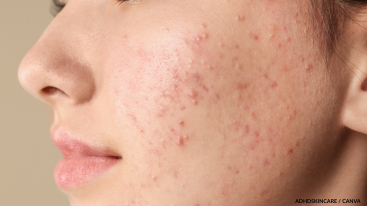
You’ve probably Googled it already: “Does Adderall cause acne?” The answer isn’t simple, but here’s what we know: Adderall has been linked to acne development, especially in individuals with acne-prone skin. While it’s not guaranteed to cause breakouts, many users report a noticeable uptick in pimples after starting the medication. Some users experience what is often called “Adderall acne,” which refers to breakouts possibly related to hormonal changes or pre-existing acne-prone skin.
The exact mechanism behind Adderall’s effects on acne isn’t fully understood, but hormonal fluctuations and increased oil production are likely to blame. For people who already struggle with oily or sensitive skin, Adderall can act like fuel on the fire.
If you’re prone to breakouts, Adderall can lead to worsening acne, especially if you’ve had a history of persistent or hormonal acne. That’s why it’s important to build a consistent skincare routine that includes acne treatments to help manage and prevent flare-ups.
You should also be aware of the potential for Adderall-related acne and take proactive steps (an Adderall skincare routine) to treat and prevent breakouts before they spiral out of control. If acne persists or causes distress, consulting a mental health professional or clinic can provide additional support for managing medication side effects.
Managing Acne Breakouts for Adderall Users
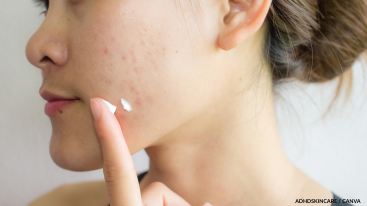
Acne breakouts can be frustrating, but they’re definitely manageable even while taking Adderall. With the right combination of skincare treatments and lifestyle changes, you can get ahead of breakouts and keep your skin in check. Here are tips that have helped members of our team:
- Don’t pick: First things first: don’t pick or pop your pimples. We know it’s tempting (especially during periods of hyperfocus or boredom), but doing so can lead to inflammation, scarring, and even more breakouts.
- Hydrate and use safe products: Instead, focus on keeping your skin hydrated and using non-comedogenic products, which means skincare that won’t clog pores. Whether your skin feels oily, dry, or a confusing mix of both, hydration is always key.
- Build an Adderall skincare routine: If you’re taking Adderall, you may need to tweak your skincare routine based on how your skin reacts. For oily skin, your focus should be on lightweight hydration, gentle exfoliation, and oil control. For dry skin, it’s all about rebuilding your moisture barrier and avoiding harsh actives.
Below, we discuss Adderall skincare routines for oily and dry skin types. Not sure of your skin type? Take our free skin type quiz. We’ll also explore the ingredients that can help mitigate the damage of Adderall on your skin.
Building an Adderall Skincare Routine for Oily Skin
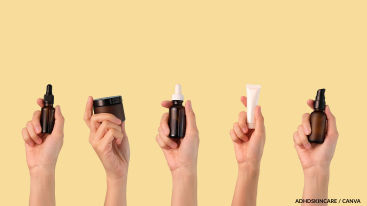
Since Adderall can cause acne breakouts, an adderall skincare routine for oily skin must cater to increased sebum production without making acne worse. We’ve created an ADHD-friendly skincare routine for oily skin that you can explore. It includes an in-depth guide, budget product recommendations, and a free downloadable. Here are the highlights.
- Gentle cleanser: Use a gentle cleanser to wash away excess oil, sweat, and buildup without stripping your skin. Know that using a harsh cleanser can have adverse effects, worsen skin issues, and cause acne flare-ups.
- Oil-control serum: Even if you do not typically include a serum in your skin care routine, you should include one to prevent developing acne breakouts and to support your Adderall-induced skin type. For oily skin, niacinamide is a mild and gentle active that will help your skin health by balancing oil production.
- Oil-free moisturizer: Follow up with a moisturizer that suits your skin type. For oily skin issues, choose a lightweight, oil-free moisturizer that won’t clog pores. Products with oil can potentially contribute to your skin’s problems.
- SPF: Sunscreen is non-negotiable. Adderall can make your skin more sensitive, especially if you’re stressed, breaking out, or starting new treatments, so protect it daily with a broad-spectrum SPF 30 or higher.
- Remove dead skin with exfoliation: And yes, exfoliation matters, but gently does it. Aim for 1–2 times a week using chemical exfoliants like salicylic acid, which is great for oily skin. Overdoing it can lead to irritation, especially if your skin is already compromised by hormonal shifts or poor sleep.
Remember that the secret ingredient to great skin for ADHD, especially those dealing with Adderall use, is a consistent Adderall skincare routine. If your acne is cystic or severe, don’t hesitate to talk to a healthcare provider or dermatologist. They can help you figure out what’s hormonal, what’s medication-related, and what needs professional treatment.
Building an Adderall Skincare Routine for Dry Skin
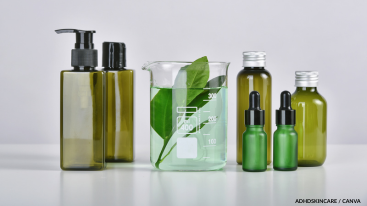
Since Adderall can cause dry, dehydrated skin, you need an adderall skincare routine for dry skin to hydrate your skin without making acne worse. We’ve created an ADHD-friendly step-by-step skincare routine for dry skin for you to check out. It includes an in-depth guide and product recommendations. Here are the highlights:
Gentle cleanser: Use a gentle, hydrating cleanser to remove buildup without stripping your skin. Harsh cleansers can potentially contribute to your skin’s problems. They can make dryness worse, weaken your skin barrier, and leave your face feeling tight, flaky, or irritated.
Hydrating serum: Even if serums aren’t part of your usual routine, consider adding one to support your Adderall-induced skin type and prevent breakouts caused by barrier damage. For dry skin, look for calming, hydrating actives like hyaluronic acid, panthenol, or beta-glucan. They draw moisture into the skin and soothe irritation without clogging pores.
Barrier-repairing moisturizer: Follow up with a rich, barrier-repairing moisturizer. Look for ingredients like ceramides, glycerin, and shea butter. They help lock in hydration and rebuild your skin’s natural defenses against dryness, flaking, and inflammation.
SPF: Sunscreen is non-negotiable. Dry, sensitive skin is more vulnerable to sun damage, especially if you’re stressed or using active treatments. Apply a broad-spectrum SPF 30+ every morning, and reapply if you’re spending time outdoors.
Remove dead skin with exfoliation: Exfoliation still matters, but keep it mild. Over-exfoliating dry skin can cause acne, lead to redness, peeling, or a damaged barrier. Stick to gentle exfoliants like lactic acid or PHA twice a week, max. These help remove dead skin cells without making things worse.
Finally, if your acne is cystic or severe, don’t hesitate to talk to a healthcare provider or dermatologist. They can help you figure out what’s hormonal, what’s medication-related, and what needs professional treatment.
Best Ingredients for an Adderall Skincare Routine to Help Fix Skin Damage

Adderall can throw your skin off balance and cause skin stress, but the right ingredients can help restore your skin barrier, reduce irritation, and keep your routine low-effort but effective. These picks work for both oily and dry skin types without overwhelming your skin.
Ceramides
- Why: Rebuild and reinforce the skin barrier, which can be damaged by internal stress and dehydration from stimulant use. Ceramides are recommended by the American Academy of Dermatology to prevent skin problems.
- Good for: All skin types, including oily or acne-prone. They’re non-comedogenic and essential.
- Tip: Look for “ceramide NP” or “ceramide AP” in the ingredients list.
Polyglutamic Acid (alternative to hyaluronic acid)
- Why: Holds more moisture than HA and sits on the skin’s surface, which helps reduce transepidermal water loss without feeling heavy.
- Good for: Oily skin (won’t clog) and dry skin (locks in hydration).
- Tip: Works great under moisturizer, even better with a mist.
Peptides (like Matrixyl, Acetyl Hexapeptide-8)
- Why: Promote skin repair, reduce inflammation, and improve texture over time without being active/exfoliating.
- Good for: Stressed-out skin, fine lines, or dullness caused by poor sleep or stimulant crash.
- Tip: Most peptide serums are light enough for oily skin and soothing for dry skin.
Centella Asiatica (Cica)
- Why: Calms inflammation and redness. Great if your skin feels overstimulated or easily irritated.
- Good for: Sensitive, breakout-prone, or stressed skin. Helps regulate oil and soothe dryness.
- Tip: Look for Madecassoside, Asiaticoside, or “Centella” in ingredients.
Beta-Glucan
- Why: A deeply hydrating, anti-inflammatory ingredient that supports healing and skin immunity.
- Good for: Both oily and dry skin, especially skin that gets reactive from dehydration or stimulant crash.
- Tip: Works especially well under moisturizer on damp skin.
Colloidal Oatmeal
- Why: Soothes itchiness, tightness, or redness from dry or compromised skin. It’s also lightly occlusive without clogging pores.
- Good for: Dry, combo, or oily-sensitive skin, especially if Adderall leaves you flaky or irritated.
- Tip: Often found in moisturizers and barrier creams (not just eczema products).
Zinc PCA (NOT zinc oxide sunscreen)
- Why: Regulates sebum and supports hydration. Unlike drying actives, this version of zinc is gentle.
- Good for: Oily skin, but won’t over-dry dry skin. Also helps calm inflammation.
- Tip: Often found in balancing or anti-acne moisturizers or toners.
How to Build a Consistent Skincare Routine With ADHD

Struggling to stay consistent? Try these ADHD-friendly tips:
- Keep it simple – Stick to 2–3 steps (cleanser, moisturizer, sunscreen).
- Place products in sight – On your desk, sink, or next to your toothbrush.
- Link to habits – Do skincare right after brushing your teeth or washing your face.
- Set timers or alarms – A daily reminder can go a long way.
- Use a checklist or sticky note – Visual cues help you stay on track.
Mitigating Potential Skin Effects of Adderall
One of the most important ways to mitigate the potential skin effects of Adderall is through an Adderall skincare routine. However, here are some extra tips that help.
- Choose non-comedogenic products to avoid clogging pores and triggering breakouts.
- Stay hydrated by drinking plenty of water to reduce the risk of dehydrated skin.
- Eat a balanced diet rich in fruits, vegetables, and whole grains to support skin health and offset potential nutrient gaps from reduced appetite.
- If acne or skin issues persist, talk to your healthcare provider.
- They may adjust your Adderall dosage or explore non-stimulant ADHD medications if needed.
- Regular check-ins with your doctor ensure your skin and overall health stay on track.
Watch Out for Allergic Reactions When Using Acne Treatments for Adderall Users
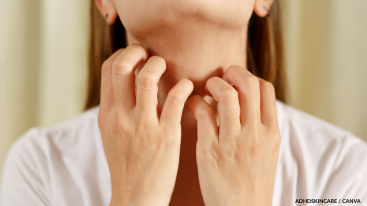
While managing acne on Adderall, it’s important to remember that not all skincare products play nice with your skin, especially if it’s already sensitive or reactive.
Adderall users should be aware of the potential for allergic reactions to acne treatments, particularly strong actives like benzoyl peroxide, salicylic acid, or retinoids. An allergic reaction can present as a rash or inflammation, which may be mistaken for acne, so it’s important to distinguish between the two for proper treatment. These ingredients can be effective, but they can also cause irritation, redness, peeling, or even hives if your skin isn’t ready for them.
If you experience burning, swelling, rash, or intense discomfort after applying a new product, stop using it immediately and seek medical attention. Don’t try to push through the reaction or “wait it out.” Your skin barrier might already be compromised from medication side effects, so it’s important to act quickly.
Always patch-test new products when possible, and introduce them slowly into your routine. If in doubt, talk to a dermatologist, especially if you’re combining acne treatments with a prescription like Adderall.
Ritalin vs. Adderall: What’s the Difference for Your Skin?
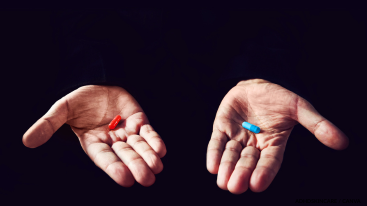
When it comes to ADHD meds and your skin, Ritalin and Adderall share a lot of common ground, but Adderall often gets the reputation for being harsher. If you’ve noticed skin changes while on either, you’re not imagining things. These stimulant medications can absolutely show up on your face. Weight loss from stimulant medications like Adderall can also contribute to a sunken facial appearance and may impact skin health and signs of premature aging.
If you are considering switching between medications or adjusting dosages, it should be done under medical supervision to avoid withdrawal symptoms and other adverse effects.
Shared Skin Concerns (Ritalin and Adderall)
Both Ritalin (methylphenidate) and Adderall (amphetamine salts) can cause:
- Dryness and dehydration
- Rashes, itching, and contact dermatitis
- Accelerated skin aging
- Acne or worsened breakouts
- Paleness or uneven skin tone
- Restlessness and skin-picking tendencies
These effects often stem from sleep disruption, increased stress hormones, and changes in hydration levels, all of which can mess with your skin barrier, oil production, and collagen.
What Makes Adderall Potentially Harsher?
Both Ritalin and Adderall can cause acne and several other side effects. However, users, including Redditors and anecdotal reports, consistently describe Adderall as having stronger or faster skin side effects, and here’s why that might be true:
1. Faster or More Visible Aging
Many users report “sunken faces,” “crepey texture,” or “deepened folds” after just days or weeks on Adderall. This may be due to stronger vasoconstriction, which limits blood flow to the skin and slows repair.
2. Hormonal Changes
Adderall may suppress estrogen and other hormones that support skin thickness and hydration. Some women notice worsened skin during PMS or after stopping birth control, hinting at a compounding effect.
3. Cortisol and Glucose Spikes
Amphetamines can increase cortisol, which contributes to:
- Inflammation
- Oil production
- Collagen breakdown
They may also mess with blood sugar, leading to glycation, a process that damages elastin and collagen and accelerates aging.
4. Compulsive Skin Behaviors
Restlessness, hyper-focus, and anxiety can cause users to develop picking or scratching habits, especially when hyper-fixated on perceived skin flaws. This can lead to scarring, open wounds, and long-term textural damage.
In essence, while both Ritalin and Adderall affect skin, Adderall’s amplified stimulant effects might hit harderespecially if you’re prone to sensitivity, anxiety, or hormonal acne.
Want to dive deeper? We break down how Ritalin affects skin in our own article and offer tailored routines for anyone navigating ADHD meds + skincare.
Frequently Asked Questions about Adderall Skincare Routines

Does Adderall cause acne?
Yes, Adderall has been linked to acne development, especially in individuals who are acne-prone or experiencing hormonal shifts. While it’s not guaranteed to cause breakouts, many users report new or worsened acne after starting the medication due to increased oil production, stress, and hormonal fluctuations.
Why does Adderall cause acne in some people and not in others?
Not everyone will react the same to Adderall. The 2022 study we discussed above revealed that women react differently to Adderall than young adults or men.
Can Adderall cause oily skin?
Yes. Adderall can trigger oily skin by disrupting your sleep, increasing cortisol levels, and potentially altering hormone balance. Even if your skin wasn’t oily before, you may notice more shine, clogged pores, or breakouts after starting the medication.
Can Adderall cause dry skin?
Also yes. Adderall may suppress thirst and disrupt your sleep cycle, which can lead to dehydration. Combined with vasoconstriction (narrowing of blood vessels), this can reduce skin hydration, leaving your skin dry, flaky, or sensitive, even if you’re drinking water.
Why does Adderall affect the skin at all?
Adderall is a central nervous system stimulant. It impacts multiple body systems, including hormones, hydration, and stress levels all of which are deeply tied to skin health. That’s why even subtle shifts in your body can show up on your face.
What should an Adderall skincare routine look like?
Your routine should match your Adderall-affected skin type. For oily skin, stick to gentle cleansers, lightweight non-comedogenic moisturizers, and oil-balancing ingredients like niacinamide. For dry skin, prioritize hydration with rich moisturizers, humectants like hyaluronic acid, and barrier-protecting ingredients like ceramides. And no matter your skin type, don’t skip sunscreen.
Explore our full ADHD-friendly routines:
ADHD-friendly skincare routine for oily skin
ADHD-friendly step-by-step skincare routine for dry skin
Should I exfoliate if I’m on Adderall?
Yes, but go gently. For oily skin, 1–2 times per week with salicylic acid can help unclog pores. For dry skin, stick to mild exfoliants like lactic acid or PHA no more than twice a week. Over-exfoliating can damage your skin barrier, especially if your skin is already inflamed or stressed.
Can acne treatments cause side effects while on Adderall?
Yes. Adderall can make your skin more sensitive to actives like benzoyl peroxide, retinoids, or salicylic acid. Start slowly and patch-test any new treatment. If you experience irritation, redness, or swelling, stop use and consult your dermatologist.
When should I talk to a healthcare provider?
- If your acne becomes cystic or painful
- If you experience severe dryness, rashes, or hives
- If your skincare products cause burning or swelling
A dermatologist can help you adjust your routine or determine if your symptoms are linked to Adderall or another issue.
What’s the difference between Adderall and Ritalin for skin?
Both can cause dryness, acne, and irritation, but Adderall tends to be harsher. Users report faster aging signs, worsened hormonal acne, and stronger vasoconstriction with Adderall. Ritalin may be a gentler option for some, though results vary.
TL;DR: Building an Adderall Skincare Routine

While Adderall may not directly cause acne, its effects on the body can potentially contribute to skin problems such as acne development and worsening acne. Understanding how Adderall affects your skin empowers you to take proactive steps, like following a consistent skincare routine, staying hydrated, and maintaining a balanced diet to support your overall skin health.
If you experience persistent or severe skin issues, don’t hesitate to reach out to a healthcare professional for guidance on managing Adderall-related acne or exploring alternative treatments, including non-stimulant ADHD medications. By staying informed and attentive to your skin’s needs, you can manage the effects of Adderall while maintaining healthy, resilient skin and overall well-being.
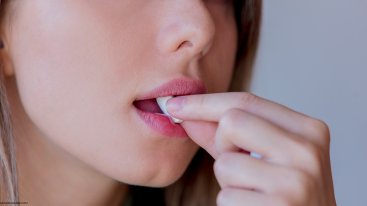
Leave a Reply